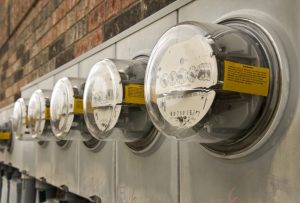 In December 2024, the Illinois Commerce Commission (ICC) granted a $606 million hike in delivery rates for ComEd and a $309 million increase for Ameren. The rulings were a step in the right direction in that they cut hundreds of millions of dollars in wasteful spending proposed by both utilities, reduced the rate hikes and did not allow increases in the companies’ profit rate for shareholders. But, of course, too many people are having a hard time affording their bills–we’ve got more work to do as consumer advocates.
In December 2024, the Illinois Commerce Commission (ICC) granted a $606 million hike in delivery rates for ComEd and a $309 million increase for Ameren. The rulings were a step in the right direction in that they cut hundreds of millions of dollars in wasteful spending proposed by both utilities, reduced the rate hikes and did not allow increases in the companies’ profit rate for shareholders. But, of course, too many people are having a hard time affording their bills–we’ve got more work to do as consumer advocates.
Below is our breakdown of ComEd and Ameren electric delivery rates and supply prices for 2025. (You can also see the rates in our Making Sense of Your Electric Bill fact sheet.)
DELIVERY RATES
What are delivery rates?
Electric bills have delivery and supply sections. All of us pay delivery rates to cover the utilities’ costs of sending electricity over their wires to our homes–plus a profit for the companies. Those charges take up about a third to a half of the electric bill.
For a decade, Illinois set electric delivery rates for ComEd and Ameren according to the state’s 2011 “Energy Infrastructure and Modernization Act.” The law, which CUB opposed, used a formula to determine delivery rates, opened the door to about $1 billion in rate hikes and was at the heart of the ComEd corruption scandal. But the Climate and Equitable Jobs Act (CEJA) launched a new system to set rates under four-year rate plans, and that has given state regulators more authority to limit rate hikes.
But there’s still more work to do. Under a provision in Illinois utility law that CUB opposes, if ComEd and Ameren don’t make the profit level that was set in the previous rate case, they are given extra money to make up the difference. (And if the utilities do better than planned, they have to reimburse customers.) This has been an unfair advantage for the utilities. In 2024, this “reconciliation” proceeding led to an extra $259 million being added to ComEd rates. As the Chicago Tribune editorialized: “One of the most obnoxious aspects of utility regulation in Illinois is that when rates are set for ComEd and downstate electricity utility Ameren Illinois, the companies are all but guaranteed a certain profit level.”
So what are we paying for delivery rates in 2025?
CUB dived into the tariffs and here’s what we found. These rates reflect the delivery rate hikes that Ameren and ComEd received on Jan. 1.
Ameren:
Meter Charge: $5.32/month (formerly $5.06/month)
Note: Covers meter-related services, such as installing, maintaining and testing meter equipment.
Monthly Customer Charge: $8.72/month (formerly $9.10/month)
Note: Helps cover the utility’s administrative costs of doing business, such as billing, postage and customer assistance.
EDT Cost Recovery Charge: 0.12550¢/kWh (formerly 0.12531¢/kWh)
Note: This charge recovers the Illinois Electricity Distribution Tax and is the same for all customer classes.
Distribution Delivery Charge Summer: 7.477¢/kWh (formerly 6.808¢/kWh).
Distribution Delivery Charge Non-Summer:
4.376¢/kWh for the first 800 kWh used (formerly 3.985¢/kWh)
2.324¢/kWh for usage over 800 kWh (formerly 2.115¢/kWh)
Note: The Distribution Delivery Charge covers the costs of maintaining equipment/wires and other costs not recovered through the customer charge.
ComEd:
Standard Metering Charge: $4.02/month (formerly $3.44/month)
Note: Covers meter-related services, such as installing, maintaining, and testing meter equipment.
IL Electricity Distribution Charge: 0.125 cents/kilowatt-hour (kWh) (formerly 0.124¢/kWh)
Note: This charge recovers the Illinois Electricity Distribution Tax and is the same for all customer classes.
Monthly Customer Charge
-
- Non-electric heat: $15.45/month for single-family homes (formerly $13.18/month), $11.62/month for multi-family (formerly $10.03/month)
- Electric heat: $17.59/month for single-family homes (formerly $15.03/month), $12.57/month for multi-family (formerly $10.85/month)
Note: Helps cover the utility’s administrative costs of doing business, such as billing, postage and customer assistance.
Distribution Facilities Charge
-
- Non-electric heat: 6.062¢/kWh for single-family (formerly 4.981¢/kWh), 4.641¢/kWh for multi-family (formerly 3.817¢/kWh)
- Electric heat: 2.924¢/kWh for single-family (formerly 2.408¢/kWh), 2.783¢/kWh for multi-family (formerly 2.290¢/kWh)
Note: The Distribution Facilities Charge covers the costs of maintaining equipment/wires, and other costs not recovered through the customer charge.
SUPPLY RATES
What are supply rates?
Supply rates cover the costs of the actual electricity. Unlike delivery charges, the utilities are not allowed to profit off the supply rate. They must pass onto customers what they pay for the electricity with no markup. Supply takes up about a half to two-thirds of your electric bill.
Note: You can opt to pay an alternative supplier for these rates–but most likely your best bet is to stay with your utility for supply. According to CUB’s review of records from the state of Illinois, consumers have lost $1.8 billion to alternative electricity suppliers since 2015.
So what are the utilities charging for supply as of Jan. 1?
The utilities’ supply rates have gone down slightly for ComEd customers and up for Ameren customers in 2024. These are the rates through May:
ComEd Price to Compare:
6.552¢ per kilowatt-hour (kWh) (That’s the same or down from October-December’s rate, which ranged from 6.470¢/kWh from November through December to 6.612 cents/kWh in October.)
Note: ComEd’s rate is expected to increase significantly as of June 1, 2025.Read CUB’s WatchBlog explanatory article.
Ameren Price to Compare:
8.277¢/kWh for 0-800 kWh of usage (up from October-December’s rate of 8.090¢/kWh)
7.693¢/kWh for usage above 800 kWh (up from December’s rate of 7.506¢/kWh)
For information on how to reduce your electric bill, check out CUB’s Energy Efficiency page and reach out for a utility bill clinic consultation at [email protected].

